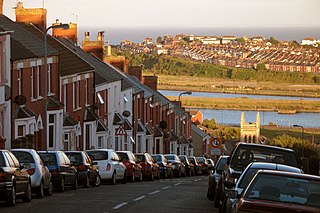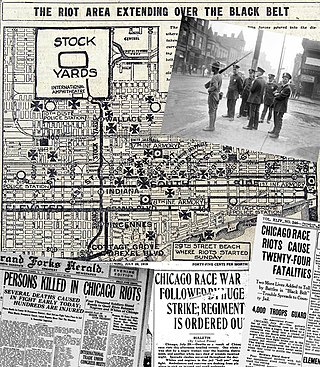Related Research Articles


Newport is a city and county borough in Wales, situated on the River Usk close to its confluence with the Severn Estuary, 12 mi (19 km) northeast of Cardiff. With a population of 145,700 at the 2011 census, Newport is the third-largest authority with city status in Wales, and seventh most populous overall. Newport became a unitary authority in 1996 and forms part of the Cardiff-Newport metropolitan area. Newport was the site of the last large-scale armed insurrection in Great Britain, the Newport Rising of 1839. The population grew considerably during the 2021 census, rising to 159,587, the largest growth of a unitary authority in Wales.

Cardiff Bay is an area and freshwater lake in Cardiff, Wales. The site of a former tidal bay and estuary, it is the river mouth of the River Taff and Ely. The body of water was converted into a 500-acre (2.0 km2) lake as part of a UK Government redevelopment project, involving the damming of the rivers by the Cardiff Bay Barrage in 1999. The barrage impounds the rivers from the Severn Estuary, providing flood defence and the creation of a permanent non-tidal high water lake with limited access to the sea, serving as a core feature of the redevelopment of the area in the 1990s.

Barry is a town in the Vale of Glamorgan, Wales, on the north coast of the Bristol Channel approximately 9 miles (14 km) south-southwest of Cardiff. Barry is a seaside resort, with attractions including several beaches and the resurrected Barry Island Pleasure Park. According to Office for National Statistics 2016 estimate data, the population of Barry was 54,673.

The Butetown branch line, also known as the Cardiff Bay Line, is a 1-mile-6-chain (1.7 km) commuter railway line in Cardiff, Wales from Cardiff Bay to Cardiff Queen Street. The service pattern used to comprise a mixture of shuttle services along the branch and through trains along the Rhymney Line to Caerphilly, or the Coryton Line to Coryton, but since December 2005 is a shuttle service from Queen Street station. The normal journey time is four minutes.

The Vale of Glamorgan Line is a commuter railway line in Wales, running through the Vale of Glamorgan from Barry to Bridgend, via Rhoose and Llantwit Major.

Barry Island railway station is a railway station, 9+1⁄4 miles (14.9 km) south-west of Cardiff Central, serving Barry Island in South Wales. The station has been the terminus – and only remaining active station at the end of the Barry branch of the Cardiff Central to Barry Island line since the closure of Barry Pier station in 1976, the last passenger working through Barry Island tunnel to the Pier station being an enthusiasts' special in 1973. Previous to that year, only a few revenue-earning workings to meet up with the former P&A Campbell's paddle-steamer trips to Weston-super-Mare or other Somerset/Devon havens, were made following May 1964.

Cadoxton railway station is a railway station serving Cadoxton and Palmerstown near Barry, Vale of Glamorgan, South Wales. It is located on the Barry Branch 6½ miles (10 km) south of Cardiff Central. The line continues to the terminus of the Barry Branch at Barry Island but from Barry Junction the line also continues as the Vale of Glamorgan branch to Bridgend via Rhoose for Cardiff International Airport bus link and then Llantwit Major.

The Barry Railway Company was a railway and docks company in South Wales, first incorporated as the Barry Dock and Railway Company in 1884. It arose out of frustration among Rhondda coal owners at congestion and high charges at Cardiff Docks as well the monopoly held by the Taff Vale Railway in transporting coal from the Rhondda. In addition, the Taff Vale did not have the required capacity for the mineral traffic using the route, leading to lengthy delays in getting to Cardiff.

Bute Street is a street in Cardiff, Wales. It links Cardiff Bay and Butetown with Cardiff city centre. It now has no road number. It runs from the dockside of the Mermaid Quay complex in the south, which is now a pedestrian zone, to the junction of Bute Terrace (A4160) in the north.

The Chicago race riot of 1919 was a violent racial conflict between white Americans and Black Americans that began on the South Side of Chicago, Illinois, on July 27 and ended on August 3, 1919. During the riot, 38 people died. Over the week, injuries attributed to the episodic confrontations stood at 537, two thirds Black and one third white; and between 1,000 and 2,000 residents, most of them Black, lost their homes. Due to its sustained violence and widespread economic impact, it is considered the worst of the scores of riots and civil disturbances across the United States during the "Red Summer" of 1919, so named because of its racial and labor violence. It was also one of the worst riots in the history of Illinois.

The timeline of Cardiff history shows the significant events in the history of Cardiff which transformed it from a small Roman fort into the modern capital city of Wales.

Cardiff Docks is a port in southern Cardiff, Wales. At its peak, the port was one of the largest dock systems in the world with a total quayage of almost 7 mi (11 km). Once the main port for the export of South Wales coal, the Port of Cardiff remains active in the import and export of containers, steel, forest products and dry and liquid bulks.
The South Wales Senior League is a former football league in South Wales. The league consisted of two divisions, named Divisions One and Two. Division One was a feeder to the Welsh Football League Division Three, and therefore sat at levels 5 of the Welsh football pyramid.

The Longview race riot was a series of violent incidents in Longview, Texas, between July 10 and July 12, 1919, when whites attacked black areas of town, killed one black man, and burned down several properties, including the houses of a black teacher and a doctor. It was one of the many race riots in 1919 in the United States during what became known as Red Summer, a period after World War I known for numerous riots occurring mostly in urban areas.

Racism in the United Kingdom refers to negative attitudes and views on race or ethnicity within the viewpoints of groups or individuals or existing systemically in the United Kingdom. The extent and the targets of racist attitudes in the United Kingdom have varied over time. It has resulted in cases of discrimination, riots and racially motivated murders. Racism was uncommon in the attitudes and norms of the British class system during the 19th century, in which race mattered less than social distinction: an African tribal chief was unquestionably superior to an English costermonger. Use of the word "racism" became more widespread after 1936, although the term "race hatred" was used in the late 1920s by sociologist Frederick Hertz. Laws were passed in the 1960s that specifically prohibited racial segregation.

Edwin Montgomery Bruce Vaughan, known as E. M. Bruce Vaughan, was an ecclesiastical architect from Cardiff, Wales.

Betty Campbell was a Welsh community activist, who was Wales' first black head teacher. Born into a poor household in Butetown, she won a scholarship to the Lady Margaret High School for Girls in Cardiff. Campbell later trained as a teacher, eventually becoming head teacher of Mount Stuart Primary School in Butetown, Cardiff. She put into practice innovative ideas on the education of children and was actively involved in the community.
The Cardiff & District League is a football league covering the city of Cardiff and surrounding areas in South Wales. The leagues are at the seventh to tenth levels of the Welsh football league system.
References
- 1 2 3 4 Evans, Neil (Spring 1980). "The South Wales Race Riots of 1919". Llafur. Society for the Study of Welsh Labour History. 3 (1): 5–7. Retrieved 13 June 2020– via The National Library of Wales.
- 1 2 3 4 5 Sutton, Shaheen (3 June 2020). "Remembering the Newport Race Riots of 1919". Wales Arts Review. Retrieved 13 June 2020.
- ↑ Evans, Neil. "The South Wales Race Riots of 1919". pp. 10–12. Retrieved 14 June 2020– via The National Library of Wales.
- ↑ "Black and White - Serious racial riot at Newport". South Wales Weekly Post. 14 June 1919. p. 2. Retrieved 13 June 2020– via Welsh Newspapers Online.
- 1 2 3 4 5 Mohammed, Aamir (16 June 2019). "The notorious Race Riots of 1919 in Cardiff that shamed Wales". Wales Online . Retrieved 13 June 2020.
- 1 2 "'One thousand people came rioting down the street': Reliving a notorious chapter in Cardiff's past". ITV News . 3 November 2018. Retrieved 13 June 2020.
- ↑ "Race riots - Smart handling of dangerous affray - Cardiff looking quieter". The Cambrian Daily Leader. 14 June 1919. p. 1. Retrieved 13 June 2020– via Welsh Newspapers Online.
- 1 2 "Done to death at Cadoxton-Barry - Discharged soldier killed by negro seaman - Great excitement in the streets". The Cambrian Daily Leader. 13 June 1919. p. 5. Retrieved 14 June 2020– via Welsh Newspapers Online.
- 1 2 Evans, Neil. "The South Wales Race Riots of 1919". pp. 14–15. Retrieved 14 June 2020– via The National Library of Wales.
- ↑ "Marking 100 years since Barry's race riots". The Barry Gem. 30 August 2019. Retrieved 14 June 2020.
- 1 2 3 "Terfysg yn Y Bae? Terfysg yn Y Barri! The history of the 1919 Race Riots goes beyond Cardiff". Nation Cymru. 18 May 2021. Retrieved 10 June 2021.
- ↑ Evans, Neil. "The South Wales Race Riots of 1919". pp. 18–19. Retrieved 14 June 2020– via The National Library of Wales.
- ↑ "Racial riots - Coloured Men Discharged". The Cambrian Daily Leader. 16 July 1919. p. 1. Retrieved 13 June 2020– via Welsh Newspapers Online.
- ↑ "Remembering the 1919 Cardiff Race Riots". Amgueddfa Blog. National Museum of Wales. 10 June 2019. Retrieved 13 June 2020.
- ↑ "Cardiff race riots of 1919: What would they look like today?". BBC News . 13 June 2019. Retrieved 13 June 2020.
- ↑ "Extra events for centenary of Race Riots in Barry in 1919 - learning from history". Bro Radio . 4 September 2019. Archived from the original on 14 June 2020. Retrieved 14 June 2020.
- ↑ "The 1919 Race Riots Project Launch". Walesremembers.org. Retrieved 13 June 2020.
- ↑ Megan Nisbet (5 May 2021). "GMB viewers praise Sean Fletcher as presenter speaks Welsh on show". Wales Online. Retrieved 10 June 2021.